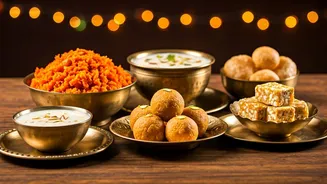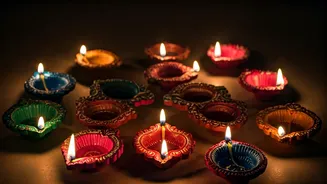Significance of Dhanteras
Dhanteras, observed on the Trayodashi Tithi of the Krishna Paksha in the month of Ashwin, holds a special place in the Hindu calendar. It is celebrated
to honor Dhanvantari, the god of Ayurveda, and is also considered a day to welcome wealth and prosperity into the home. During Dhanteras, people often purchase gold, silver, and new utensils, viewing them as symbols of good fortune. This festival is an integral part of Diwali and is marked by the worship of Lakshmi, the goddess of wealth. The rituals associated with Dhanteras are believed to bring blessings of health, wealth, and overall well-being. The act of consuming specific foods on this day is a continuation of ancient customs, designed to invite positive energy and prosperity into one's life.
The Six Sacred Foods
The tradition emphasizes consuming particular foods on Dhanteras, each with a unique symbolism. The exact list can vary by region, but some foods are consistently recognized as auspicious. The most common foods include sweets, especially those made with milk and dry fruits, representing sweetness and abundance. Another essential food is rice, symbolizing prosperity and the promise of a plentiful harvest. Dry fruits and nuts are also consumed, signifying wealth and good fortune. Furthermore, lentils are often included, believed to bring financial stability. Spices like turmeric and ginger are used, both for their health benefits and their perceived ability to ward off negative energies. Finally, specific regional sweets and savory dishes might be prepared, depending on the family's traditions and preferences.
Sweet Delights: Milk-Based Treats
Milk-based sweets hold a significant place in the Dhanteras food tradition, symbolizing purity and prosperity. These sweets are often prepared using milk, sugar, ghee, and various dry fruits. The process of making these sweets, such as barfi, peda, or kheer, is seen as an offering of devotion. The sweet taste also represents happiness and the positive experiences one hopes to have in the coming year. Families often prepare these sweets at home, or purchase them from local sweet shops. The act of sharing these sweets with family and friends further symbolizes the sharing of joy and the welcoming of prosperity. The rich textures and flavors of these treats add to the festive mood, making Dhanteras a truly special occasion.
Grains of Abundance: Rice Dishes
Rice, a staple grain in India, also holds a significant position in Dhanteras traditions, signifying abundance and prosperity. Various rice dishes, ranging from simple boiled rice to elaborate preparations like rice pudding (kheer), are prepared and consumed. The preparation of rice for Dhanteras is often accompanied by prayers and rituals, signifying gratitude for the harvest and a hope for continued wealth. In some regions, rice is used in the rangoli designs created to welcome Lakshmi into the home. Eating rice on Dhanteras is seen as an act of acknowledging and inviting good fortune, with the belief that it will ensure a year of plenty. The versatile nature of rice allows for a variety of dishes to be prepared, catering to different tastes and regional preferences, making it a prominent part of the Dhanteras feast.
Dry Fruits: Symbols of Wealth
Dry fruits and nuts are an essential part of the auspicious foods consumed on Dhanteras, symbolizing wealth, health, and prosperity. Almonds, cashews, raisins, and walnuts are commonly included. These are often eaten raw, added to sweets, or used in various festive dishes. The presence of these expensive foods reflects a wish for financial well-being and abundance. They also symbolize the richness of life and the ability to enjoy the finer things. Families often gift dry fruit boxes to each other as a token of well wishes. Consuming dry fruits on Dhanteras is a tradition, designed to bring blessings of prosperity and health. They are a delightful treat and a reminder of the good things in life, making Dhanteras a celebration of both wealth and well-being.
Lentils: Stability and Fortune
Lentils, a staple in Indian cuisine, are also significant during Dhanteras, representing stability and financial security. Various lentil-based dishes are consumed, such as dal (lentil soup) and various savory preparations. The inclusion of lentils symbolizes the desire for a stable financial future and the grounding of one's resources. Eating lentils on Dhanteras is seen as a way of inviting the blessings of wealth and ensuring that there is a solid foundation for financial growth. Their nutritional value further adds to the perceived benefits, as they support health and well-being, which is considered essential for achieving prosperity. Lentil-based dishes, prepared in various styles across different regions of India, add a savory element to the Dhanteras feast, and embody the desire for a well-rounded and prosperous life.
Spices: Protection and Health
Spices like turmeric and ginger, known for their health benefits, are also incorporated into the Dhanteras food traditions. They are used in various dishes, not only for their flavor but also for their believed protective qualities. Turmeric, with its anti-inflammatory properties, symbolizes good health and vitality. Ginger, known for its digestive benefits, symbolizes the strength to overcome challenges. The consumption of these spices signifies a desire for both physical health and the warding off of negative energies. Many families believe these spices provide a form of protection, ensuring the health and well-being of the household throughout the year. The addition of spices enhances the taste of the foods and acts as a symbol of care, making Dhanteras a celebration not only of prosperity but also of health and well-being.

















